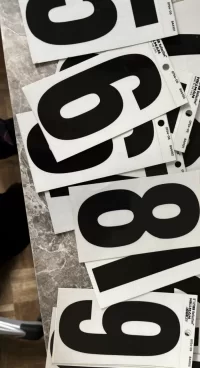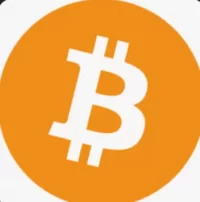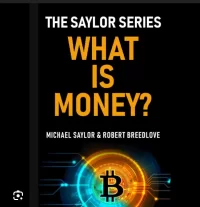MJ DeMarco
I followed the science; all I found was money.
Staff member
FASTLANE INSIDER
EPIC CONTRIBUTOR
LEGACY MEMBER
Read Rat-Race Escape!
Read Fastlane!
Read Unscripted!
Due to popular request via this thread and also here...
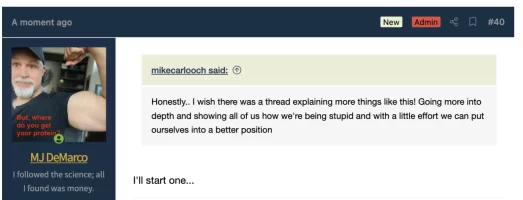
I thought I'd create a core thread that highlights some basic financial skills that can help you transition from Slowlane to Fastlane.
These strategies have helped me preserve capital and made me debt free most of my life.
The following strategies can be used immediately by anyone. However, it also can be applied in an advanced fashion, which I demonstrate in below in my own stories.
Ultimately, they can save you MILLIONS and make decision making much easier.
STRATEGY #1: Interest Rates are a Key Decision-Metric on WHEN and WHERE to Assign or Borrow Money
If you owe money, pay close attention to the interest rate at which you are being charged. This rate determines YOUR ROI on any principle prepayments.
For example, if you're being charged 24.9% on revolving credit card debt, this means EARLY REPAYMENT gives you an immediate guaranteed 24.9% yield.
Are you earning 24.9% in the bank? In some bond? In stock?
Likely not and it certainly is NOT guaranteed.
This means your "best investment" is not saving money, but paying off this high interest loan to reap this 24.9% yield.
While there are some arguments on how to attack debt, I believe THE MOST EXPENSIVE LOANS should be attacked first, ranked by interest rate cost. Dave Ramsey argues the snowball approach; attack your smallest loan first, pay it off, and then move to the next smallest debt.
Ramsey's snowball method is MOTIVATIONALLY better because it fires the feedback loop quicker...
The higher interest rate method is FINANCIALLY better.
Example:
Debt Portfolio #1 - Financial Method
Pay first: Credit Card #1: $22,000 @ 22.9%
Pay second: Car Loan: $9,000 @ 15%
Pay third: Credit Card #2: $2,000 @ 11.9%
Pay last: Student Loan: $25,000 @ 4%.
Debt Portfolio #1 - Motivational Method
Pay first: Credit Card #2: $2,000 @ 11.9%
Pay second: Car Loan: $9,000 @ 15%
Pay third: Credit Card #1: $22,000 @ 22.9%
Pay last: Student Loan: $25,000 @ 4%.
Using Interest Rates to Determine CASH vs DEBT decision
This idea of using an INTEREST RATE as a decision metric just doesn't apply to prepayment of loans, but also, the TAKING OF LOANS.
I've been debt free most of my life. However, when I do own debt, it is because it was a strategic financial decision, not because I couldn't afford the asset.
Strategy #1 is a perfect example on how I used to buy my home. Here are the details which I outlined in a past Fastlane newsletter.
I copied it below:
In my purchase evaluation, I weighed several factors for determining if I should buy a pretty large and expensive property. They were:
Ultimately, the combination I decided to buy because the decision was a good one, based on the above factors, and as a reward, I leveled up on my dream home.
Here's how it played out: First, I put down 66% cash on this home and financed the remaining $1.8M with a 7/1 adjustable-rate mortgage (ARM) at a staggeringly low rate of 2.25%. Yes, 2.25%. This was my cost of money and I knew at the time, interest rates would be rising.
This is the key wisdom.
I knew interest rates would be rising, which would mean my $1.8M that I didn't put into my home, I could put into other higher yielding assets, and eventually, get my mortgage paid via better investments yielding greater than 2.25%. In hindsight, I probably should have financed more.
So why a dangerous adjustable rate loan, which if adjusted today, would be at 7%? Because my pay-off time horizon was only 3-5 years.
The seven-year term gives me flexibility if I have other short-term needs for idle cash, like second homes, cars, or better investments—like today. Three years in, I already have half of the mortgage paid off.
This decision also allowed me to get a significant stack of money out of idle cash...
I didn't buy an legacy estate; I bought precious land, bricks, drywall, copper wire, kitchen appliances, roofing material, and more.
These are all hard assets that don't stand to lose money; they stand to inflate. And despite the recent slide in housing prices, I made sure to buy in a growing, highly-desirable area.
Today, my home has lost little to no value. The rebuild cost would not be my original purchase price, but at least $1.5M more. And now, because I have a low 2.25% mortgage, I can invest my idle cash in virtually anything and get my mortgage paid off with plenty left over.
Interest on $1.8M @ 2.25% = $40,500 annually.
Interest on $1.8M @ 5%* = $90,000 annually.
5% is an easily accessible yield in today's rate environment. In fact, I'm getting paid 5% tax free yields in some places. So not only is my mortgage getting paid from municipal investments, I'm not incurring any tax liabilities in doing so.
In other words, because I accepted a cheap money loan yesterday, today my investments can quickly pay my mortgage with simple investments in REITs, muni bonds, or dividend-paying stocks, many of which already have depressed prices. All of those pay 5% or better. I get paid a $50,000 bonus for allowing my higher-rate investments to freely pay my mortgage.
Can you imagine the insanity?
This "too good to be true" magic was all made possible because of one of the best decision-making tools available today: Financial Intelligence.
Strategy #2: Normalize Interest Rates for After-Tax Measurements: What You Keep is What Matters.
I mentioned that SGOV and BIL (US Treasuries) yields around 5%, paid monthly.
ETX, a closed end municipal bond fund also pays around 5%, paid monthly.
Except the former is taxable.
The latter is not.
This means the effective NET yield -- THE MONEY I KEEP -- is far different.
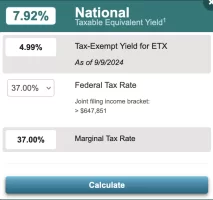
Here is how this translates:
SGOV / BIL would need to yield 7.92% to be the equivalent investment to ETX.
$1,000,000 invested in BIL/SGOV = $50,000 yearly income = Post Tax Take Home = $33,500
$1,000,000 invested in ETX = $50,000 yearly income = Post Tax Take Home = $50,000.
This is a $16,500 difference — cash in your pocket.
This same concept applies to business decisions regarding SELLING or KEEPING your business.
Strategy #3: Sell or Keep Your Business? Normalize the "Take Home" Cash to Make a Better Decision
Your business generates $2.4M in cash flow / profits yearly.
You are offered $15M for your company.
Should you take the deal?
While the decision to take or decline the offer is highly personal, the math and after-tax numbers could make a highly desirable case for selling.
Here's how: (This is a simplified tax case based on an S-Corp or LLC Structure)
The sale of businesses are subject to long-term capital gains rates, which currently is taxed at 20%.
Selling the business gives you $12,000,000 IMMEDIATELY.
If you are generating $2.4M in profit on your business, you likely are keeping about $1.6M and subject to earned income and marginal taxes, top rate = 37%.
$12M after tax net of selling business / 1.6M after tax yearly income = 7.5 years to accumulate 12M.
This means it will take you 7.5 YEARS to earn that same $12M, assuming your income stays the same and does not decline. (Of course, it might increase too!)
This also DOES not take into account the present value calculations of the cash flow.
$12M paid over 7.5 years is actually only worth about $9.8M -- so now, you're down a big rabbit hole. In AFTER-TAX + AFTER-INFLATION calculations, you really need more like 10-11 years to get that same $15M, or $12M after tax.
This is why when you are making financial decisions, TAXES (what you keep!!!!) and INFLATION must always be accounted into your decision-making process.
The above analysis is why selling my business the 2nd time was a "no-brainer" -- I went through this calculation and the decision was a screaming "SELL! SELL! SELL!"
More to come later... feel free to add...

I thought I'd create a core thread that highlights some basic financial skills that can help you transition from Slowlane to Fastlane.
These strategies have helped me preserve capital and made me debt free most of my life.
The following strategies can be used immediately by anyone. However, it also can be applied in an advanced fashion, which I demonstrate in below in my own stories.
Ultimately, they can save you MILLIONS and make decision making much easier.
STRATEGY #1: Interest Rates are a Key Decision-Metric on WHEN and WHERE to Assign or Borrow Money
If you owe money, pay close attention to the interest rate at which you are being charged. This rate determines YOUR ROI on any principle prepayments.
For example, if you're being charged 24.9% on revolving credit card debt, this means EARLY REPAYMENT gives you an immediate guaranteed 24.9% yield.
Are you earning 24.9% in the bank? In some bond? In stock?
Likely not and it certainly is NOT guaranteed.
This means your "best investment" is not saving money, but paying off this high interest loan to reap this 24.9% yield.
While there are some arguments on how to attack debt, I believe THE MOST EXPENSIVE LOANS should be attacked first, ranked by interest rate cost. Dave Ramsey argues the snowball approach; attack your smallest loan first, pay it off, and then move to the next smallest debt.
Ramsey's snowball method is MOTIVATIONALLY better because it fires the feedback loop quicker...
The higher interest rate method is FINANCIALLY better.
Example:
Debt Portfolio #1 - Financial Method
Pay first: Credit Card #1: $22,000 @ 22.9%
Pay second: Car Loan: $9,000 @ 15%
Pay third: Credit Card #2: $2,000 @ 11.9%
Pay last: Student Loan: $25,000 @ 4%.
Debt Portfolio #1 - Motivational Method
Pay first: Credit Card #2: $2,000 @ 11.9%
Pay second: Car Loan: $9,000 @ 15%
Pay third: Credit Card #1: $22,000 @ 22.9%
Pay last: Student Loan: $25,000 @ 4%.
Using Interest Rates to Determine CASH vs DEBT decision
This idea of using an INTEREST RATE as a decision metric just doesn't apply to prepayment of loans, but also, the TAKING OF LOANS.
I've been debt free most of my life. However, when I do own debt, it is because it was a strategic financial decision, not because I couldn't afford the asset.
Strategy #1 is a perfect example on how I used to buy my home. Here are the details which I outlined in a past Fastlane newsletter.
I copied it below:
In my purchase evaluation, I weighed several factors for determining if I should buy a pretty large and expensive property. They were:
- INFLATION: The desire to get out of cash and into a hard asset, an asset that likely won't depreciate as fast as inflationary fiat currency.
- THE COST OF MONEY: At the time, 30-year mortgage rates were sub 3%, the lowest ever.
- THE INVESTMENT CLIMATE / COST OF MONEY: At the time, the stock market and bond prices were overpriced and highly risky. While the government was denying the existence of rising inflation, I saw it in reality. I knew interest rates would soon rise, and bond prices would fall, as well as stock prices.
Ultimately, the combination I decided to buy because the decision was a good one, based on the above factors, and as a reward, I leveled up on my dream home.
Here's how it played out: First, I put down 66% cash on this home and financed the remaining $1.8M with a 7/1 adjustable-rate mortgage (ARM) at a staggeringly low rate of 2.25%. Yes, 2.25%. This was my cost of money and I knew at the time, interest rates would be rising.
This is the key wisdom.
I knew interest rates would be rising, which would mean my $1.8M that I didn't put into my home, I could put into other higher yielding assets, and eventually, get my mortgage paid via better investments yielding greater than 2.25%. In hindsight, I probably should have financed more.
So why a dangerous adjustable rate loan, which if adjusted today, would be at 7%? Because my pay-off time horizon was only 3-5 years.
The seven-year term gives me flexibility if I have other short-term needs for idle cash, like second homes, cars, or better investments—like today. Three years in, I already have half of the mortgage paid off.
This decision also allowed me to get a significant stack of money out of idle cash...
I didn't buy an legacy estate; I bought precious land, bricks, drywall, copper wire, kitchen appliances, roofing material, and more.
These are all hard assets that don't stand to lose money; they stand to inflate. And despite the recent slide in housing prices, I made sure to buy in a growing, highly-desirable area.
Today, my home has lost little to no value. The rebuild cost would not be my original purchase price, but at least $1.5M more. And now, because I have a low 2.25% mortgage, I can invest my idle cash in virtually anything and get my mortgage paid off with plenty left over.
Interest on $1.8M @ 2.25% = $40,500 annually.
Interest on $1.8M @ 5%* = $90,000 annually.
5% is an easily accessible yield in today's rate environment. In fact, I'm getting paid 5% tax free yields in some places. So not only is my mortgage getting paid from municipal investments, I'm not incurring any tax liabilities in doing so.
In other words, because I accepted a cheap money loan yesterday, today my investments can quickly pay my mortgage with simple investments in REITs, muni bonds, or dividend-paying stocks, many of which already have depressed prices. All of those pay 5% or better. I get paid a $50,000 bonus for allowing my higher-rate investments to freely pay my mortgage.
Can you imagine the insanity?
This "too good to be true" magic was all made possible because of one of the best decision-making tools available today: Financial Intelligence.
Strategy #2: Normalize Interest Rates for After-Tax Measurements: What You Keep is What Matters.
I mentioned that SGOV and BIL (US Treasuries) yields around 5%, paid monthly.
ETX, a closed end municipal bond fund also pays around 5%, paid monthly.
Except the former is taxable.
The latter is not.
This means the effective NET yield -- THE MONEY I KEEP -- is far different.

Here is how this translates:
SGOV / BIL would need to yield 7.92% to be the equivalent investment to ETX.
$1,000,000 invested in BIL/SGOV = $50,000 yearly income = Post Tax Take Home = $33,500
$1,000,000 invested in ETX = $50,000 yearly income = Post Tax Take Home = $50,000.
This is a $16,500 difference — cash in your pocket.
This same concept applies to business decisions regarding SELLING or KEEPING your business.
Strategy #3: Sell or Keep Your Business? Normalize the "Take Home" Cash to Make a Better Decision
Your business generates $2.4M in cash flow / profits yearly.
You are offered $15M for your company.
Should you take the deal?
While the decision to take or decline the offer is highly personal, the math and after-tax numbers could make a highly desirable case for selling.
Here's how: (This is a simplified tax case based on an S-Corp or LLC Structure)
The sale of businesses are subject to long-term capital gains rates, which currently is taxed at 20%.
Selling the business gives you $12,000,000 IMMEDIATELY.
If you are generating $2.4M in profit on your business, you likely are keeping about $1.6M and subject to earned income and marginal taxes, top rate = 37%.
$12M after tax net of selling business / 1.6M after tax yearly income = 7.5 years to accumulate 12M.
This means it will take you 7.5 YEARS to earn that same $12M, assuming your income stays the same and does not decline. (Of course, it might increase too!)
This also DOES not take into account the present value calculations of the cash flow.
$12M paid over 7.5 years is actually only worth about $9.8M -- so now, you're down a big rabbit hole. In AFTER-TAX + AFTER-INFLATION calculations, you really need more like 10-11 years to get that same $15M, or $12M after tax.
This is why when you are making financial decisions, TAXES (what you keep!!!!) and INFLATION must always be accounted into your decision-making process.
The above analysis is why selling my business the 2nd time was a "no-brainer" -- I went through this calculation and the decision was a screaming "SELL! SELL! SELL!"
More to come later... feel free to add...
Dislike ads? Become a Fastlane member:
Subscribe today and surround yourself with winners and millionaire mentors, not those broke friends who only want to drink beer and play video games. :-)
Membership Required: Upgrade to Expose Nearly 1,000,000 Posts
Ready to Unleash the Millionaire Entrepreneur in You?
Become a member of the Fastlane Forum, the private community founded by best-selling author and multi-millionaire entrepreneur MJ DeMarco. Since 2007, MJ DeMarco has poured his heart and soul into the Fastlane Forum, helping entrepreneurs reclaim their time, win their financial freedom, and live their best life.
With more than 39,000 posts packed with insights, strategies, and advice, you’re not just a member—you’re stepping into MJ’s inner-circle, a place where you’ll never be left alone.
Become a member and gain immediate access to...
- Active Community: Ever join a community only to find it DEAD? Not at Fastlane! As you can see from our home page, life-changing content is posted dozens of times daily.
- Exclusive Insights: Direct access to MJ DeMarco’s daily contributions and wisdom.
- Powerful Networking Opportunities: Connect with a diverse group of successful entrepreneurs who can offer mentorship, collaboration, and opportunities.
- Proven Strategies: Learn from the best in the business, with actionable advice and strategies that can accelerate your success.
"You are the average of the five people you surround yourself with the most..."
Who are you surrounding yourself with? Surround yourself with millionaire success. Join Fastlane today!
Join Today


